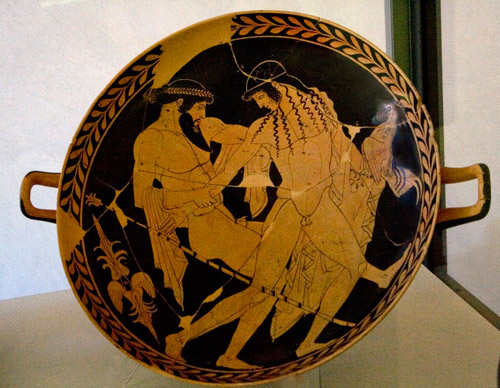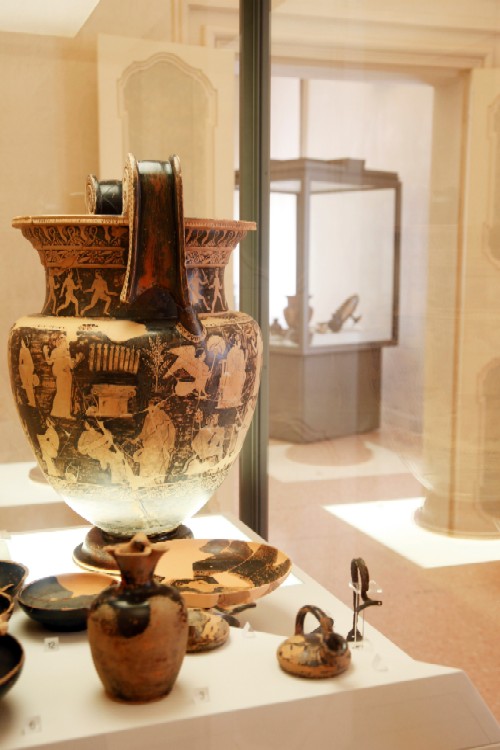
Room II
Standing out amongst the oldest tombs in the necropolis are tombs 867 from Valle Trebba and 41D from Valle Pega (early fifth century BC) which, even though different in ritual, display two identical black-glazed pelikai, decorated on the neck with a lion and a lioness in a horrific attitude, with ruffled manes and wide open jaws. British scholar Sir John D. Beazley attributed these two elegant vases to the Berlin Painter, one of the most eminent artists of Athens in the late archaic period.

The proof of taste for ostentation in the upper classes of Spina are the containers of unusual size, specially commissioned to the Athenian potters, such as the large red-figure kylikes (cups) by the Penthesilea Painter, which serve as a framework for extraordinary painted stories filled with profound ideological content (475-450 BC). The two kylikes from the tombs 212B and 18C of Valle Pega belong respectively to the initial and final phase of the artist, in the transition from the protoclassical to the classical style. On the less ancient cup, which is also the largest red figure kylix found so far, are the deeds of Theseus, which aim at celebrating the city of Athens during the period of its greatest political and commercial expansion.

The metal artifacts that accompany the ceramic containers are mainly intended for the preparation of the funeral banquet. There are numerous objects appearing throughout the fifth and the first half of the fourth century BC, especially those in bronze of Etruscan production, whose purpose was to store, stir and serve wine, prepare and present food, and light up the rooms. The Etruscans were skilled metallurgists who had an abundance of raw materials, which sprawned a production of high quality bronze ornaments and banquet tableware of the highest level, both in the traditionally known centres of Etruria, like Vulci, and in the workshops which emerged in Campania, Northern Etruria and the Po Valley. Refined Etruscan bronzes were among the main objects which were exchanged with the Greek world.

Room III
The oldest tombs , with vessels produced in the workshops of Athens in the late sixth and early fifth century BC, show the adhesion of the inhabitants of Spina to the” Greeklifestyle”, identified in the practice of the symposium. While resting from their rich mercantile activities, the rich inhabitants of Spina, who had to live in theseinhospitable environments, allowed themselves the pleasure of being together in friendly company, talking, drinking and listening to music. Proof of this is the banquet tableware, which is also present in the tombs: the krater used to mix wine, cups and candelabra to light up the darkness of the Underworld, artifacts with distinctly male valence in the oldest tombs, that in the course of the fifth century BC become habitual also in the female ones.
Symbolic references to the presence of the human race on earth and to the changing of the seasons are sometimes enclosed in mythical stories painted on Greek vases, inspired by now lost pictorial cycles. In the iconographic complexity of the volute krater of the tomb 127 of Valle Trebba, dated to 420 BC, episodes of the myths of Dionysus and Apollo are interwoven with the myth of Hephaestus, the god of Fire expelled from Olympus, and exaltat “metis”, the cunning intelligence, common to both men and gods. In this representationthe painter Polion celebrates the Athenian values of symposium, musical education and religious games, values that the people of Spina were able to make their own.

Next room